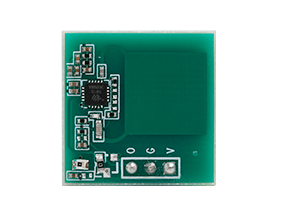AirTouch AT581x Radar
The AirTouch AT581x radar
(aka AT581x ) is a family of 5.8GHz radar which can be used for human presence detection. It can detect tiny movements
and compared to a PIR sensor it can detect presence continuously. This can be useful, for example, to turn
the lights on when you enter a room, keep them on as long as you are there (without waving your hands at the
sensor) and turn them off almost immediately after you leave the room.
They are ultra-low power (as low as 40µA of current consumption) and are extremely simple to use, yet can be setup by I2C. It’s installed in many low cost appliance, like the ESP32S3-BOX-3, and can be found by many different manufacturer or reference, like the MoreSense MS58-3909S68U4.
It is possible to use this sensor with only a single GPIO pin; however, if you wish to change its settings, a I²C Bus component (and its requisite GPIO pins) is required in your device’s configuration.

# Example configuration entry
at581x:
id: "Radar"
i2c_id: bus_aComponent/Hub
You need to have the hub component (at581x: entry) defined to be able to change the sensor’s
settings, get it listed as an motion entity or being able to turn on/off the radio frequency emmission.
A GPIO Binary Sensor alone could be sufficient if you only want
to determine presence/occupancy. When you define at581x: you’ll need to have a i2c: entry in
your configuration with both the SDA and SCL pins defined.
Multiple instances of this component may be defined if multiple I²C Bus components are available:
at581x:
- id: mmWave_1
i2c_id: bus_a
address: 0x28
- id: mmWave_2
i2c_id: bus_a
address: 0x29
...Configuration variables
id (Optional, ID): Manually specify the ID used for code generation. Necessary if you want to define multiple instances of this component.
i2c_id (Optional, ID): Manually specify the ID of the I²C Bus if you want to use multiple I2C buses.
Binary Sensor (GPIO)
The state of the radar detection is available via its GPIO pin. It’s required to use a GPIO binary sensor to monitor the motion status
binary_sensor:
- platform: gpio
name: "Human in front"
pin: GPIOXX- Refer to other options from Binary Sensor and GPIO Binary Sensor.
Switch
Switch components are used to enable/disable radio frequency hardware.
switch:
- platform: at581x
at581x_id: Radar
name: "Enable Radar"Configuration variables
at581x_id (Optional, ID): The ID of the AT581x component defined above. Required when multiple instances of the
at581xcomponent are defined.All other options from Switch.
Actions
at581x.settings Action
⚠️ Warning
The hardware frontend reset option is only required to reset the frontend in case it is struck, before sending the new configuration. However, a frontend reset is always performed after changing the settings.
The radar has several settings which can be changed. These settings are not saved in non-volatile memory and need to be set on each boot.
The settings action allows changing of any number of the radar’s internal parameters/settings. With this action, any unspecified parameters will remain unchanged.
on_...:
- at581x.settings:
id: "Waveradar"
hw_frontend_reset: false
frequency: 5800MHz
sensing_distance: 200 # 0-1023
poweron_selfcheck_time: 2000ms
protect_time: 1s
trigger_base: 500ms
trigger_keep: 10s
stage_gain: 3 # 0-12 the higher the value the smaller the gain
power_consumption: 70µAConfiguration variables
id (Optional, ID): Manually specify the ID of the sensor on which settings should be changed. If only one radar is defined, this is optional.
hw_frontend_reset (Optional, boolean): If set to true, a reset of the analog frontend will be performed before changing other options. Ignored if not set or set to
false. Upon applying the settings a frontend reset will be performed anyway, this is only useful if the sensor is not answering or locked up.frequency (Optional, int): Any of the possible frequencies (5696, 5715, 5730, 5748, 5765, 5784, 5800, 5819, 5836, 5851, 5869, 5888) in MHz.
sensing_distance (Optional, int): A unitless number, in range 0-1023, specifying the maximum distance to detect motion
poweron_selfcheck_time (Optional, int): The delay to perform self check and calibration on power on. Recommended not to change this
protect_time (Optional, int): The delay after an end-of-trigger event where the detection will not trigger anymore. Max 65535ms
trigger_base (Optional, int): The delay while a detection must be active to change the state of the sensor. Max 65535ms
trigger_keep (Optional, int): The delay that the output will stay high after a detection event. This is usually what you want to change.
stage_gain (Optional, int): The analog gain to use for threshold test. Any value in range 0-12, with 12 being the lowest gain and 0 the highest
power_consumption (Optional, int): Any of the possible power profile (48, 56, 63, 70, 77, 91, 105, 115, 40, 44, 47, 51, 54, 61, 68, 78) in µA
at581x.reset Action
Restart the sensor.
on_...:
at581x.reset:Configuration variables
- id (Optional, ID): Manually specify the ID of the AT581x component. Useful when multiple instances of this component are defined.

